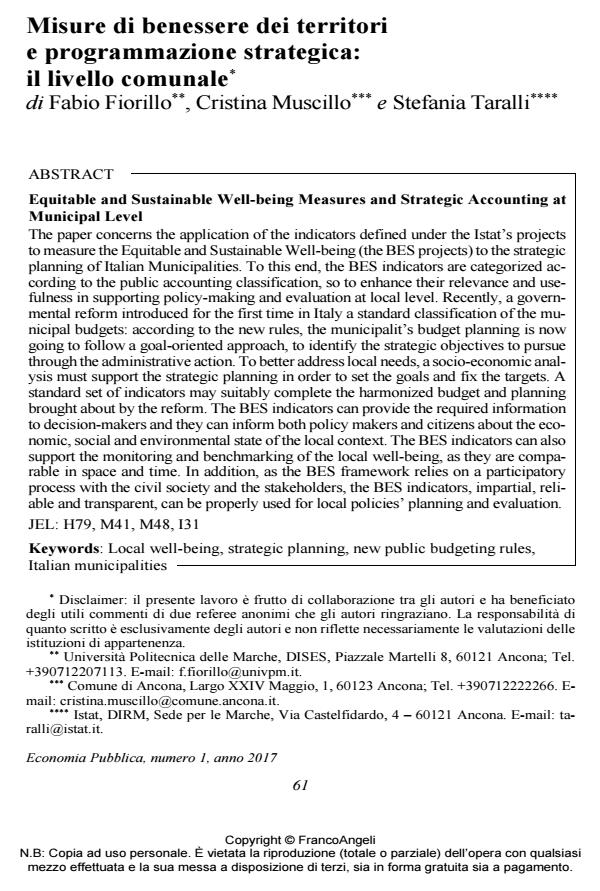Equitable and Sustainable Well-being Measures and Strategic Accounting at Municipal Level
Journal title ECONOMIA PUBBLICA
Author/s Fabio Fiorillo, Cristina Muscillo, Stefania Taralli
Publishing Year 2017 Issue 2017/1
Language Italian Pages 36 P. 61-96 File size 434 KB
DOI 10.3280/EP2017-001003
DOI is like a bar code for intellectual property: to have more infomation
click here
Below, you can see the article first page
If you want to buy this article in PDF format, you can do it, following the instructions to buy download credits

FrancoAngeli is member of Publishers International Linking Association, Inc (PILA), a not-for-profit association which run the CrossRef service enabling links to and from online scholarly content.
The paper concerns the application of the indicators defined under the Istat’s projects to measure the Equitable and Sustainable Well-being (the BES projects) to the strategic planning of Italian Municipalities. To this end, the BES indicators are categorized according to the public accounting classification, so to enhance their relevance and usefulness in supporting policy-making and evaluation at local level. Recently, a governmental reform introduced for the first time in Italy a standard classification of the municipal budgets: according to the new rules, the municipalit’s budget planning is now going to follow a goal-oriented approach, to identify the strategic objectives to pursue through the administrative action. To better address local needs, a socio-economic analysis must support the strategic planning in order to set the goals and fix the targets. A standard set of indicators may suitably complete the harmonized budget and planning brought about by the reform. The BES indicators can provide the required information to decision-makers and they can inform both policy makers and citizens about the economic, social and environmental state of the local context. The BES indicators can also support the monitoring and benchmarking of the local well-being, as they are comparable in space and time. In addition, as the BES framework relies on a participatory process with the civil society and the stakeholders, the BES indicators, impartial, reliable and transparent, can be properly used for local policies’ planning and evaluation.
Keywords: Local well-being, strategic planning, new public budgeting rules,
Jel codes: JEL: H79, M41, M48, I31
Fabio Fiorillo, Cristina Muscillo, Stefania Taralli, Misure di benessere dei territori e programmazione strategica: il livello comunale in "ECONOMIA PUBBLICA " 1/2017, pp 61-96, DOI: 10.3280/EP2017-001003